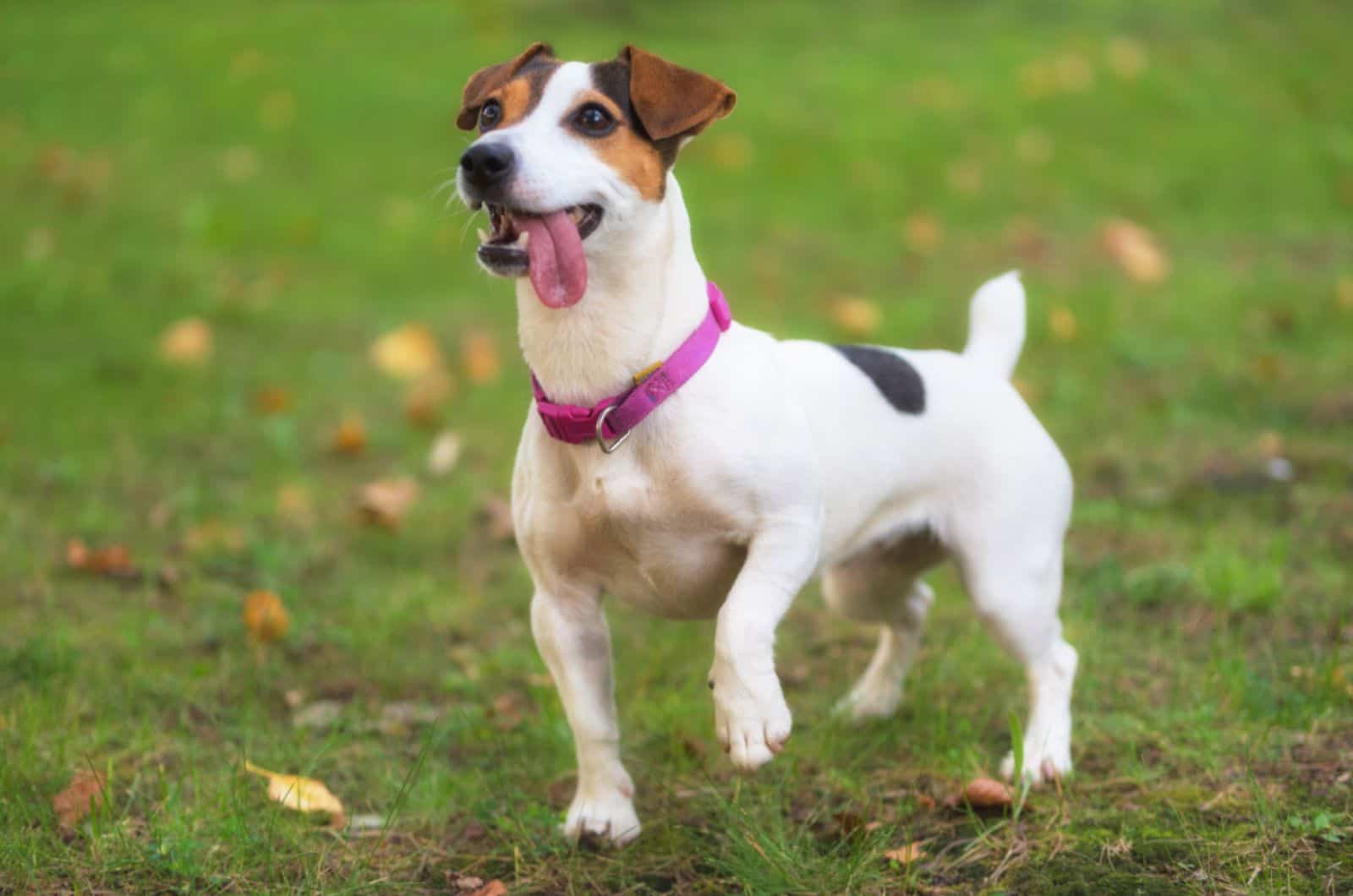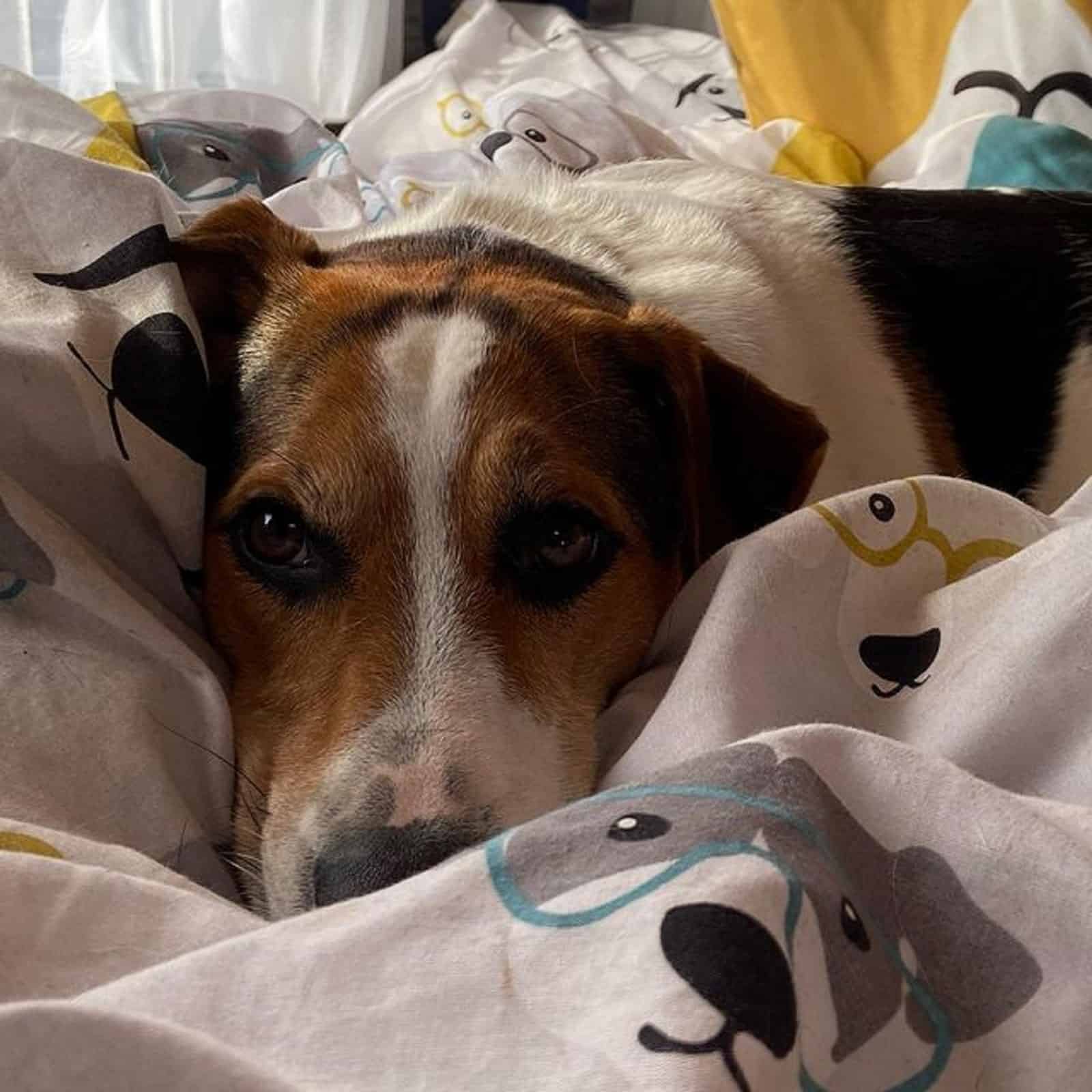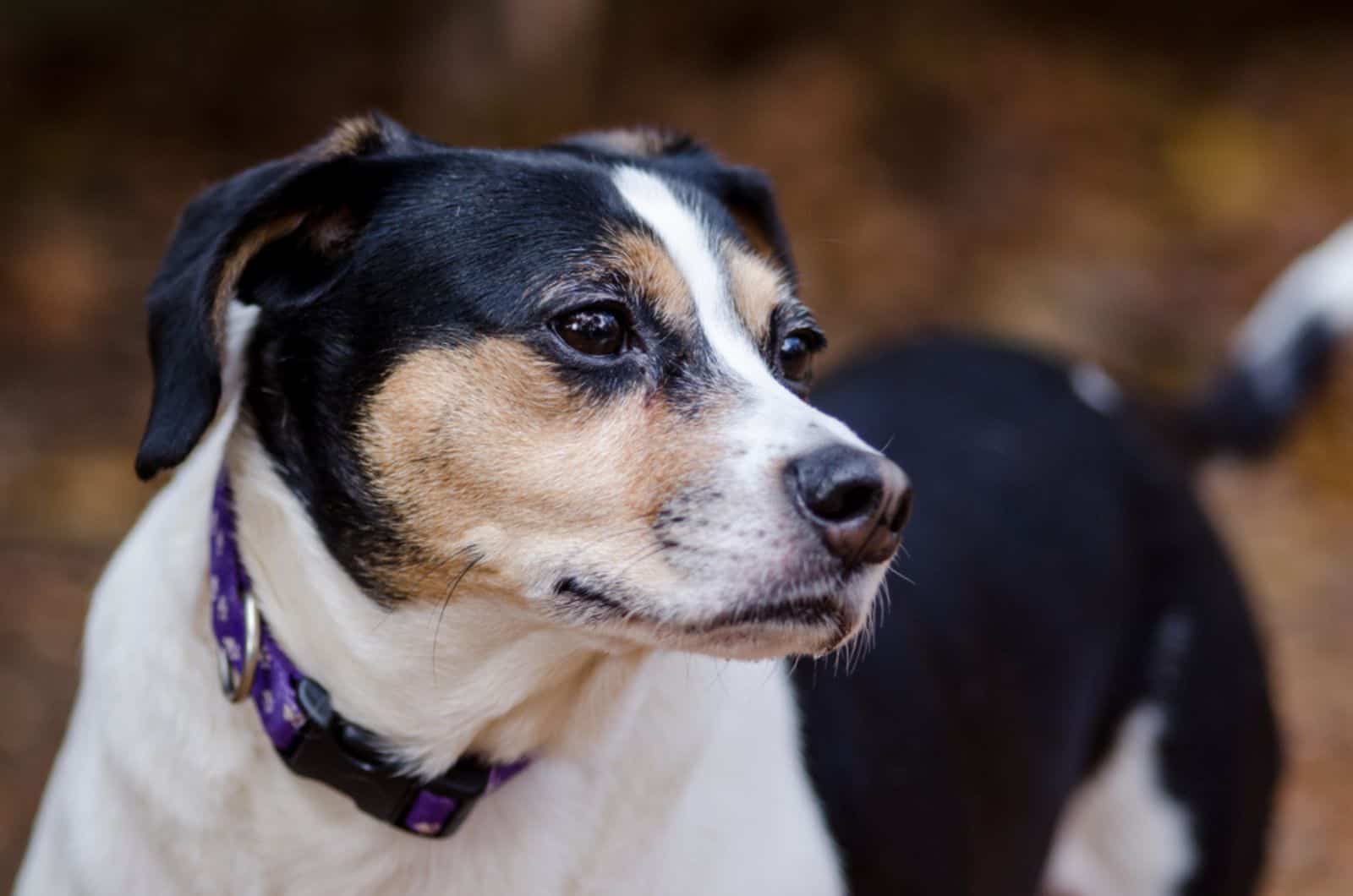Both the Jack Russell Terrier and the Beagle are adorable and friendly dogs, great pets to have for both novice and experienced dog owners, but what about the Jack Russel Beagle mix, the Jackabee?
The Jack Russel Beagle mix is a truly exceptional creation, the perfect hound dog one might call him.
It takes the best of both breeds and fuses them into one neat little package, the insanely capable hunting instinct of the Jack Russell Terrier as well as his high energy levels together with the golden nose of a Beagle belonging to a master tracker.
All of this culminates in the birth of the Jackabee, a dog that was and still is valued by hunters worldwide, but also makes for great and natural pest control around the house for families.
The Jackabee is also an avid digger, so don’t be surprised to find plenty of holes in your garden from his most recent escapades.
And, considering how small the resulting crossbreed is, you don’t need to have a massive amount of space to house him in as he can function in relatively small ones.
The breed, however, does have a few shortcomings which may make it somewhat tough to train, so it’s not exactly a breed recommended for novice dog owners and pet parents alike, but for the more experienced ones who are capable of taming this little rascal.
That said, there are plenty of things that one will need to understand about the crossbreed itself as well as his parent breeds before one can even attempt such a thing.
It’s important to get acquainted with as much of the material as you can to make it easier for yourself if you’re dead set on getting yourself a representative of this fine breed.
So, be sure to read on to discover everything the breed has to offer as well as its many requirements, other things to look out for when raising one, and find answers to some of the most commonly asked inquiries about the breed.
The Jack Russell Beagle Mix – What Is It Exactly?

While it’s unknown where the breed first originated from, it’s believed that this designer dog came about somewhere around the era of the 90’s where everyone was trying to create the next big thing in dog owner culture.
That’s why it’s understandable that it got lost somewhere along the line, though we’re all glad that it did.
As mentioned prior, the likely aim was to create the ultimate tracking dog, one who has a high prey drive and great hunting instinct while having the skills to boot with a keen sense of smell and the ability to dig any potential clues, or prey, out.
And they had all of these incredible talents packed into the two would-be purebred parent breeds, already renowned hunting dogs in their own right, the Beagle and the Jack Russell Terrier dogs.
The result was the Jackabee, though it would seem it would occur through a lot of trial and error, as the desired traits wouldn’t always end up being passed on over to the new litter.
The Side Effects Of Crossbreeding
This also resulted in a variety of other visual distinctions, namely coat patterns or one set of Jackabee puppies having longer legs while the others ended up with shorter ones.
Speaking of which, the new breed looked stunningly beautiful too, equally as adorable as his parents with a distinct country charm to him given the coloration.
However, as perfect as the breed seemed to be, there were a few kinks still, the main one being the one I mentioned at the start which is just how difficult it is to train these mixed breed dogs.
Sure they’re small, but the high prey drive and hunting instinct that are so valued are a double-edged sword and give this dog a real attitude to boot.
It can be tough to come out ahead when training these dogs which is why I didn’t really recommend the Jack Russel Terrier Beagle mix to people only coming into the world of pets, but it is possible, though a lot of perseverance is needed.
To understand where all of this comes from, we’ll need to take a look at the Jackabee dog’s parent breeds.
The Parent Breeds
The two parent breeds of the Jackabee are interesting in their own right and may be a better option if you’re a first time dog owner as they’re a lot easier to handle.
They can be your segway into getting a Jack Russell Beagle mix puppy later down the line once you get a better hang of how dog training works and how you ought to treat your dog at certain points in time.
Here’s what these two have to offer.
The Jack Russell Terrier

Breed History
The Jack Russell Terrier is a relatively old-ish breed, with its current iteration appearing near the end of the 18th century, bred by reverend John Russell using two English Terriers.
Given that the man was a parson, the alternate name for the breed also became the Parson Russell Terrier.
Oddly enough, the Jack Russell Terrier was born out of a need for a dog that could stand out during hunts and wouldn’t have a similar coat pattern or color as the prey that he was hunting, which, at this time, were foxes.
And he’d succeed, creating the lovely breed that we know today.
However, that wasn’t the only redeeming trait that this new dog breed ended up having.
Their relatively tempered hunting instinct was what they were prided for as well, where they would never go in for the killing blow, and would mostly seek to capture their prey rather than kill it to preserve the sport, so to speak.
This was a highly valued trait and what ended up elevating the breed’s popularity and causing it to spread to other countries.
That said, they weren’t considered to be an official breed for the next 50 years at least, only being officially recognized around the year 1850.
Around the time of World War II, the breed would suffer immensely given the declining desire for hunting.
Their numbers would dwindle, but one person over in the US, Alisa Crawford, would retain their number and would be one of the main reasons why they’re present on our soil.
She founded the JRTCA (Jack Russel Terrier Club of America) and has kept the breed’s qualities from being diluted through Jack Russell cross breeding.
The breed was officially recognized by the AKC (American Kennel Club) in 2001 allowing it entry into AKC certified conformation shows.
Size
The Jack Russell Terrier can be classed as somewhere between a small and medium size dog breed, coming out to around 10 to 15 inches in terms of height, and about 15 to 18 lbs in terms of weight, give or take a few inches or pounds depending on various factors.
RELATED: Jack Russell Growth Chart: Things To Know
Temperament
Despite his small stature, the Jack Russell Terrier is a pretty high energy dog with a high activity level.
They’re also brave and intelligent to boot, unafraid to chase down any prey or intruder that may come their way.
They’re known to employ various tactics aside from just barking to get their target to back off.
They have a decently high prey drive which has served them well for hunting smaller animals, but can be a nuisance for pet parents who just want them as family dogs as they tend to try and keep others in line by nipping or barking at them.
That’s why early socialization with young kids and other dogs is important in their behavioral training.
They’re extremely loyal and affectionate which can be a double-edged sword if they’re left alone for longer periods of time as they’re known to either get bored too quickly or lonely.
This ends up causing them to act out and tear into some of your belongings to grab your attention.
That’s why they need to get enough mental and physical stimulation throughout the day. Around 90 minutes of moderate physical exertion is recommended for JRTs on average.
Coat Colors
The one other thing (aside from a few health issues) that the Jack Russell Beagle mix dog, the Jackabee, inherits are the colors of its parent breeds. These are the ones that are more likely to come from the JRT:
- Black and White
- White and Tan
- White and Chestnut
- Tri-Color (Black, White, and Brown)
- Lemon White
- Red and White
The Beagle

Breed History
While the direct age at which Beagles came about is lost to history, some of the earliest dated records of the Beagle show them to appear somewhere around the 11th century in similarities between the Southern Hound and the Harrier.
It was at this time where William the Conqueror crossbred the Talbot hound and St. Hubert hound with a Greyhound to conceive this old breed.
They were pretty different compared to what the Beagle is today. Namely, they were slower and larger than the modern iteration.
As time passed, their size would diminish, and they’d become somewhat of a popular breed among the royalty of England as a popular choice of hunting dog.
They were used to chase after prey through smaller spaces that the larger dogs couldn’t fit through.
Later, they were repurposed from hunting bigger game to going after smaller animals like rabbits.
This still wasn’t the modern iteration of the Beagle though, despite their name, as these were dubbed ‘glove’ or ‘pocket’ Beagles, relative to their size.
The Birth Of The Modern Version
The roots of the modern version of the breed are believed to have originated somewhere around the early 19th century from a man called Reverend Phillip Honeywood.
His Beagles resembled more of what the modern day ones did, with adequate size and other features.
Thomas Johnson followed after him, developing the modern Beagle around the year 1840.
They arrived in the US 30 years later through general Richard Rowett over in Illinois and, by the year 1885, his version was the one recognized by the AKC as the breed standard for the modern Beagle.
RELATED: What Were Beagles Bred For: The History Of This Dog Breed
Size
The Beagle is also considered to be a small to medium sized dog breed, measuring at around 11 to 16 inches in height on average, similar to the Jack Russell Terrier, and weighing in at around 12 to 20 lbs, give or take a few from each measurement.
RELATED: Beagle Growth Chart: Everything You Need To Know Before Buying
Temperament
Despite being a hunting dog, the Beagle ends up being a really gentle soul who doesn’t get aggressive often.
Instead they’re incredibly friendly and lovable on average, and mesh well with humans.
The latter can be detrimental if you’re using him as a guard dog as he won’t really bark at people who he grows a liking to, but he will still bark at strangers or anything unfamiliar to him.
While this may mark them off as naive, the Beagle is still incredibly intelligent and has a lot of stamina, allowing him to go for long distances without feeling any sort of exhaustion.
That said, they’re incredibly stubborn too, often having tunnel vision with a singular goal in mind when given an order.
This means they’re a lot harder to train than most dog breeds if you can’t successfully rein it in.
Much like the JRT, they do get bored easily if their needs aren’t met, which aren’t too steep, only around an hour of moderate physical exertion is needed, as well as some mental stimulation via toys or your attention.
Despite a lot of these shortcomings, they make for great family doggies and don’t really need mandatory socialization at an early age, but it won’t do him any harm.
Coat Colors
Beagles too have a variety of coat colors that may end up transferring over to the Jackabee, though only 8 are accepted as the breed standard by the AKC.
They are as follows:
- Black & Tan
- Black Red & White
- Black Tan & Bluetick
- Black Tan & White
- Black White & Tan
- Blue Tan & White
- Brown & White
- Brown White & Tan
- Lemon & White
- Red & White
- Tan & White
The Jackabee

Now that we’ve covered the purebred dog parent breeds of the Beagle Jack Russell mix, it’s time to talk about this wonderful dog breed and see what traits it has inherited from said parents.
Breed History
Once again, I wanted to touch upon what little is known about the breed.
Its actual date of conception is unknown aside from a potential range which can encompass anywhere from the 1990’s to around the year 2000, maybe a bit further.
Because of this, the main breeder of this mixed breed also can’t be determined.
However, we do know that the original intent was to create a dog who would inherit the Beagle’s incredible sense of smell and stamina, and the Jack Russell Terrier’s naturally high prey drive.
They also wanted a dog that was small enough to be able to traverse the rough terrain of their hunting grounds with ease and still be easy to spot and discern from the prey being hunted which the JRT’s white coat kindly provided.
Breeding one with the perfect traits can be tough, which is likely why finding Jackabee breeders is hard to do nowadays as well considering the challenges that come along with, and the luck factor of hitting every trait needed.
Though, nowadays, a lot of those traits aren’t needed if people are looking for family dogs and are often looking for a breed that’s a bit more tempered toward children and other dogs.
These things are something that more skilled dog owners can accomplish with this great dog.
Their Appearance
The size of the Jackabee will be somewhat equivalent to that of his parents, coming up to around 10 to 15 inches in height and a weight of around 16 to 30 pounds on average.
He may be a bit taller depending on which type of Jackabee he ends up being as they can manifest with either short or long legs.
He’s also likely to inherit the Beagle’s long and floppy ears which further aid with that keen sense of smell by trapping the scents and directing them toward the nostrils.
He’s a bit heavier than his parents, but it doesn’t affect him as much, though it does make him look a bit more filled out in places, adding to his charm.
The coat itself can end up being on the longer end that looks like a coarse mess, or it can end up being very neat, sleek and short.
He can even get a mix of the two that looks even weirder, but still oddly fitting to the crossbreed.
As far as his fur color is concerned, that can vary wildly depending on the coats of the parents in question, but even then it can manifest as something completely different.
The most common coat colors that the Jack Russell Beagle mix ends up having are:
- Tri-color
- Chocolate tri
- White
- White and chestnut
- White and chocolate
- Blue belton
- White and orange
- White and lemon
- White and red
Grooming Needs

Given the three possible coat types, there are different grooming methods you’ll need to adhere to, though it’s nothing too complicated.
For the ones with neater, shorter hair, they only need to get brushed once a week or so as they won’t shed too much.
For the ones that have the longer, or more wiry hair, it’s recommended to give them a brushing daily if possible, to keep the hair off the furniture.
Aside from that, you’ll need to keep their nails trimmed too. It’ll help minimize any potential damage to your furniture if you allow him up there or if he’s left alone and decides to act out.
It also helps keep his hygiene up and reduces potential risks of paw infection.
RELATED: Long-Haired Jack Russell Terrier: Is There Such A Thing?
Temperament
As we’ve seen earlier in the article, his parents aren’t exactly the calmest of dogs given their high energy reserves, the Jack Russell Terrier in particular, but the Beagle to a degree as well, despite its mild-mannered nature.
Given how the Jackabee inherited the Jack Russell Terrier’s keen hunting instincts, he too ends up being extremely energetic and unruly, making training somewhat difficult if you can’t keep up with him.
He’s also relatively easily distracted, much like his Beagle parent, so it’s recommended that you don’t take him off-leash around crowded areas, in open dog parks or anywhere near cars to prevent any potential accidents from occurring.
I’d say he sits somewhere between the Poodle and Chihuahua in terms of composure, not as well behaved as the former at the start, but also not nearly as aggressive as the latter.
Though, despite not being the best dog in terms of behavior at the start, the Jack Russell Beagle mix is still incredibly loyal and lovable.
Another positive of the dog is that, given his small stature, he doesn’t really need much room to be happy so he can work in a lot of apartments if need be.
Still, he’ll need to get some early socialization done with other dogs and small children, the sooner the better as it’ll make him be more tolerant around others and the sooner he’ll become a good family pet.
He does inherit the high levels of separation anxiety from both parents, so don’t be surprised if you come home to torn furniture or shoes if you didn’t satisfy his daily exercise requirements.
Exercise Needs
The Jack Russell Beagle mix is about as demanding in his daily exercise needs as his parents, requiring somewhere between 60 to 90 minutes of moderate exercise per day.
It’s best that it’s a mix of walkies and playtime, be it with his toys or playing with you, though I do recommend that any sort of playing be done in an enclosed space so he doesn’t end up getting into any sort of danger.
It may be simple advice, but it can be a real lifesaver for your canine companion.
Training
As for the rest of his behavioral training, the best way to go about it is through positive reinforcement, but also not forgetting to not be too forgiving with it.
Make sure he knows when he does something good, and that he understands when he does something that’s not appropriate.
They respond well to food as a reward, so depriving them of a treat when they do something bad will let them know what’s right and what isn’t real quick.
Now, whether you do it yourself or with the assistance of a professional dog trainer is up to you, but I do recommend the latter as it’ll make your job a lot easier later down the line, especially if you’re not all that experienced with owning a pooch yet.
Potty training at an early age can be a pain though as the Jack Russell Beagle mix tends to be unable to hold it in all that well, so be ready to wipe some potential messes.
Food And Nutrition

As far as food and overall nutrition go, you’ll want a diet with very little carbohydrates, and a relatively high protein count.
The average adult Jackabee should eat food that has about 18% protein in it, while pups get ones with a bit more protein %, around 20-22, depending on his age.
They need a bit more as they still need to develop their lean muscle mass while they’re growing for their body to keep up.
The best protein options for your dog are chicken and beef respectively, with fish being an alternative option, albeit less liked by dogs.
Bone And Joint Health
Other than that, you’ll want dog food that contains good amounts of calcium and phosphorus during your Jackabee’s puppy years.
They help develop strong and healthy bones and joints too, as well as some glucosamine and chondroitin to maintain good joint and bone health.
The need for those will somewhat wane as he grows older, but once he reaches his senior years, he may need it again in case of issues revolving around joint and bone pain in particular.
Skin And Fur Health
Omega 3 and 6 fatty acids are important too, for maintaining good skin and fur health, to keep the former moisturized and to maintain their natural oils from being scraped off.
Overall Beneficial Nutrients
Other than that, you’ll want DHA and EPA for your pups, key nutrients for healthy cognitive development.
Then, some probiotics are always useful to help foster the growth of healthy gut bacteria to improve his overall immune system.
Antioxidants aren’t a must, but are a welcome, optional addition if you can score one in your Jackabee’s kibble of choice as they’ll improve his cardiovascular health, reducing the risk of potential heart disease.
Naturally, you’ll want to make sure it’s made out of all-natural ingredients with as little artificial nonsense and hazardous chemicals as possible.
If your dog has an allergy to a particular ingredient, be sure to avoid that like the plague to not give your dear doggo much trouble.
As for the type of food that you should be feeding him, stick to dry dog food over the wet stuff.
The former is great for his teeth to fight tartar and plaque build-up and you often get more bang for your buck.
The latter may be tastier to your dog given the added moistness, but it’ll stain his teeth and is often more fattening, not to mention more expensive.
You can get him the wet stuff every now and then, but it’s better for your dog (and your wallet), if his main source of nutrition remains the dry dog food.
If you want to spice things up, you can always add some bone broth or something similar as gravy over the kibble to add a bit of extra flavor and soften his meal up for him.
Health Issues
Now, no dog, no matter how healthy, can avoid health problems forever, and our dear Jackabee is no exception to this.
While he does have relatively healthy parents, it doesn’t mean he gets to escape some of the issues that could have potentially plagued them that have now been inherited by this mixed dog breed.
Here are some of the more common ones:
Elbow And Hip Dysplasia
Elbow and hip dysplasia are one of the more common issues that every dog has to face, though it’s more common in heavier and larger dogs.
It, however, can affect any dog, including the Jackabee here.
It’s a condition where the hip joint dislocates from its socket, causing great discomfort in your dog and a lame walk.
Sadly, there’s no real cure for it, but pain relief can be provided and further damage can be prevented.
The best way to minimize the chances of this happening involve the usual, a healthy diet with plenty of exercise which your pooch should be getting regardless.
The aforementioned chondroitin and glucosamine inclusion in foods is a decent way to further boost your dog’s chances at avoiding this problem.
Patellar Luxation
Other than hip and elbow dysplasia, there’s another bone related problem, patellar luxation.
A luxating patella is a condition where the kneecap is dislocated off the actual knee, causing pain and discomfort for the dog.
This one, however, can get treated through a surgical procedure, but it’s best to get it done early so any further damage can be prevented.
The main cause tends to be genetic, so there isn’t much that can be done about prevention, though it can also be caused by severe trauma, so keep your dog safe and he may just end up avoiding this particular issue.
Legg-Calve-Perthes Disease
The Legg-Perthes disease is another one, one that usually happens early on in a dog’s life, if at all. It mostly ends up affecting smaller dog breeds.
It’s essentially a slow degradation of the hip joint which then causes lameness and a gradual inability to put pressure on the affected leg.
Normally it’ll only affect one leg on a side, never two at the same time.
There are treatments to help relieve the pain, but surgery usually tends to be the final solution should medical treatment fail to relieve the issue.
Intervertebral Disc Disease
The final one in the bone issue category is the intervertebral disc disease, essentially a hernia that can form between two spinal discs which applies pressure and creates a growing discomfort for the dog.
It’s a disease the Jack Russell Beagle mix is genetically prone to thanks to his Beagle parent, but it isn’t as serious as it sounds, at least in mild cases.
It’s usually treated through medication and rest, something that’s definitely not in the lifestyle description of a Jackabee, but it’s something that must be done to allow the condition to heal on its own.
If your dog refuses to stay put and allows the condition to worsen, then he risks further damage to the spine and even paralysis in the worst of cases.
But, surgery is possible, and, as long as the symptoms aren’t too severe yet, the chances of a successful surgery are pretty high.
Chondrodysplasia
Next on the list is Chondrodysplasia, also known as dwarfism in dogs. While it normally affects larger dogs, small dogs can be affected too.
It’s caused with a reduced production of the growth hormone and it ends up affecting not just the dog’s bones, but his cartilage as well.
It’s not something that can be cured given that it’s a genetic condition, but medical treatment does exist which can allow your dog to live for a good while, but dwarfism does make him prone to a lot of other potential health issues.
Issues With The Thyroid Gland
Hypothyroidism is another one, a condition where the thyroid gland has a thyroid hormone deficit, causing your dog to act sluggish, lose patches of fur and start suddenly gaining weight at an increased rate.
While it is treatable through hormone supplements, it is a lifelong condition unfortunately, but your dog can still live a full life even with it.
Epilepsy
Another relevant, and dangerous problem is epilepsy, an issue that comes from the Beagle side of the tree which causes seizures due to a developmental abnormality.
While rare, it can happen, and there’s no real cure for it, but there are anti epileptic drugs that can be taken to reduce their severity.
Thankfully, they can live out a relatively normal life with the addition of medication, though some dogs who have less severe symptoms can do without said medication too.
Just make sure to keep an eye out for when said seizure does happen and keep him under supervision at all times.
Cataracts
An eye disease this time around, one where the lens in the eye becomes progressively clouded and can cause a gradual loss of vision.
Thankfully, it’s easily cured via routine surgical procedure that removes the cataracts, so it’s not the biggest of issues, but it’s best to notice the condition early.
Glaucoma
Another one relating to a dog’s eyes, one that can be potentially severe depending on how long it’s allowed to linger, glaucoma.
It’s a condition that your Jackabee can contract where there’s an increase in ocular pressure, when the drainage of the aqueous humor in the eye isn’t sufficient and causes a fluid build-up.
While its early symptoms are hard to detect, the swelling of the eye or unusually high fluid discharge from it are a good indicator that something is wrong.
The condition is treatable through medication and follow-up surgical procedures depending on the severity of the issue,
Though, ultimately it shouldn’t be a problem unless the condition becomes too severe to the point where it has caused irreversible damage to the affected eye.
Obesity
An issue that plagues any dog is that of becoming overweight.
It’s something that’s completely avoidable, but is also something that can easily happen in small dog breeds given how gaining 5 extra pounds for a Jackabee isn’t the same as 5 extra pounds on a German Shepherd.
So, be wary of how good your dog’s metabolism is and balance his meals adequately. There’s a lot of trial and error in this process, but if he does end up becoming obese, he’ll be a lot more prone to a lot of the issues mentioned above, and some others.
Parasites
Finally, we have an issue that’s pretty common among all dogs, but one that isn’t to blame on their genes, but rather accidents.
Various parasites can infect your dog’s body, usually through contaminated food and they end up latching deep into his digestive system, draining the nutrients from the food that he ingests and taking it for themselves.
The most common ones tend to be ringworms, tapeworms and hookworms specifically.
These can leave pretty glaring and lasting consequences on your canine companion if left untreated, especially if your Jackabee contracts it while he’s still a pup as he’ll need those nutrients to properly develop.
Not having access to them will lead to malnourishment and potential abnormal growths.
Thankfully, these parasites are easy to get rid of once spotted.
The moment you notice your dog acting lethargic or having a distinct lack of appetite while clearly losing weight at an expedited pace, call up your local vet to schedule an examination.
If worms end up being the cause of it and not some other underlying health issue, then the dog will get dewormed and he should be back to normal shortly.
Given how big an impact these parasites can have on your dog’s life, it’s a good practice to do routine check-ups even if the results come back negative, as it’s a good preventative measure.
If your dog doesn’t seem willing to go to the vet himself, you can always deliver a stool sample for analysis over to the veterinarian.
RELATED: Beagle Lifespan And Common Health Issues Explained
Lifespan

Despite all of the numerous potential health problems that may occur, all of them are exceedingly rare or happen when your dog is well into his senior years, or are simply easily curable.
That’s why the Jack Russel Beagle mix enjoys a relatively long life on average, anywhere between 12 to 16 years with 13 being the average.
It all depends on his genetics, levels of exercise and quality of diet.
Cost
The Jackabee isn’t awfully expensive due to being a mixed dog breed and the need for a hunting dog diminishing greatly in modern times.
They usually go from anywhere between $400 to $700, give or take a few dozen bucks.
This is because they’re not officially recognized by the AKC so demand isn’t all that high, and the aforementioned difficulty to handle.
That said, it’s not the only cost you’ll need to pay as there’s a lot of money that’ll be spent on dog gear, vaccinations, toys, dog food and the like.
So, even though it may look cheap at first glance, know that it will be an extra expense to your budget for a long while. Make sure you’re able to afford all of this before getting yourself a new doggo.
FAQs
Are Jackabees Good Dogs?
They have their charm, but they’re not the best family pets to own, especially not if you’re a novice pet parent, as I’ve said before in the article.
They are, however, pretty great if you tend to have frequent problems with pests and other smaller animals in or around your household.
Is The Jack Russell Beagle Mix Dog The Right Option For You?
This entirely depends on you.
They’re decent dogs who look absolutely beautiful, with their small size adding to their incredible charm.
However, you have to accept that these dogs require a lot more care and attention than some other dog breeds would.
They require someone experienced to get them to behave and conform to being a family pet.
They tend to be stubborn and unruly at times with a very big case of separation anxiety if their needs aren’t met.
Not to mention that if you’re looking for a show dog, the Jackabee certainly isn’t it as mixed breeds aren’t recognized by the American Kennel Club.
However, they are incredibly loyal and intelligent dogs, ones who’ll reciprocate the love you give them tenfold.
They’re extremely high energy which can promote a more active lifestyle for you as well, and not just them, should you commit to them.
They live relatively healthy lives, so you usually won’t have to end up having to spend a lot on medical expenses and you won’t have to worry about them at every corner.
And, ultimately, they’re incredibly affordable, but that’s partly influenced by some of their shortcomings.
I’m by no means trying to dissuade you from getting one. I’m just saying that every dog is a big responsibility.
It’s like having an extra child to take care of, one that you answer for.
So, only get one if you think you can provide him with a decent life, otherwise both you and him will end up grabbing the short end of the stick here, and nobody wants that to happen.
In Conclusion
The Jack Russell Beagle mix is a relatively high maintenance dog that isn’t recommended for novice dog owners.
Though, while it does have its many shortcomings given all of the requirements needed from the owner to be, the dog is still a lovable little bundle of happiness and excitement.
They require lots of daily exercise, both mental and physical and have a bad case of separation anxiety if left alone for too long.
Early socialization and overall behavioral training are needed to somewhat stifle the high prey drive the dog has inherited from his parent breeds.
If all of that can be accomplished, alongside the standard needs of raising a pet like healthy dieting and routine physical examination, then you’ll be able to manage this one just fine, though I still urge you to think well and hard about it as it is a big decision.
However, whatever you decide on, I’m sure it’ll be the best choice for you and your potential future furry friend. Until next time, pet parents.
RELATED LINKS:
- 13 Best Jack Russell Breeders In The US
- A Jack Russell Feeding Chart For Your Dog To Get Jacked
- Are Jack Russell Terriers Hypoallergenic? How Much They Shed?
- Top 7 Beagle Breeders In Oregon — Best Beagles In The State
- The Beagle Feeding Chart: Building The Ideal Dog Diet
- 26 Beagle Mixes, So Adorable To Die For
